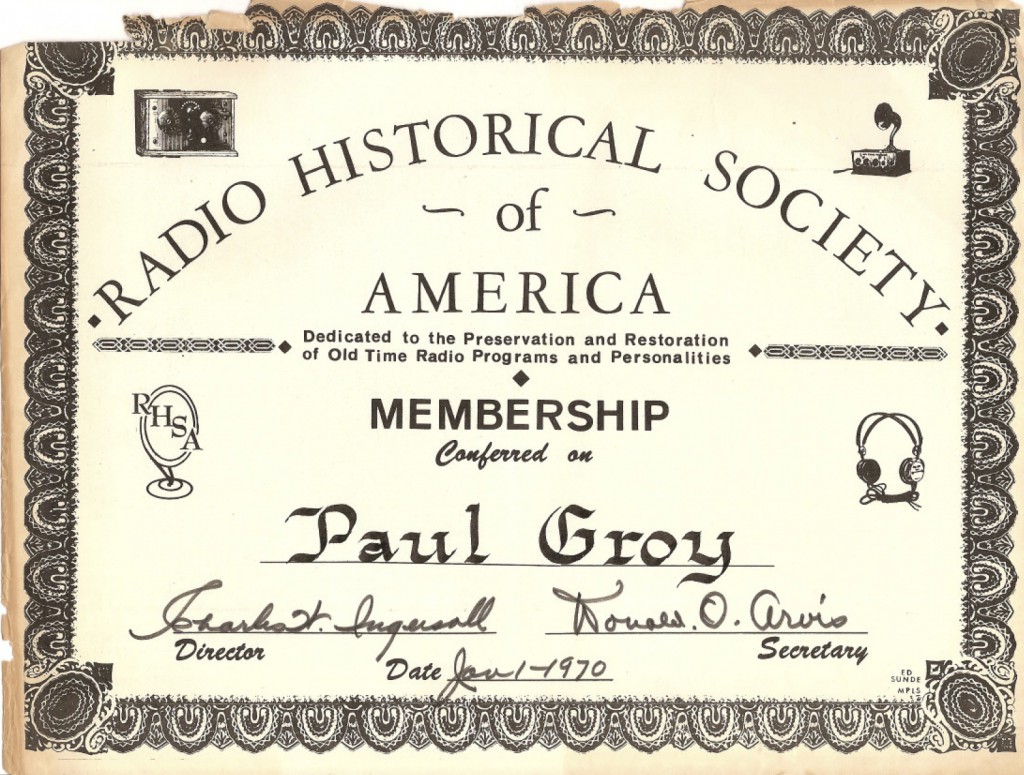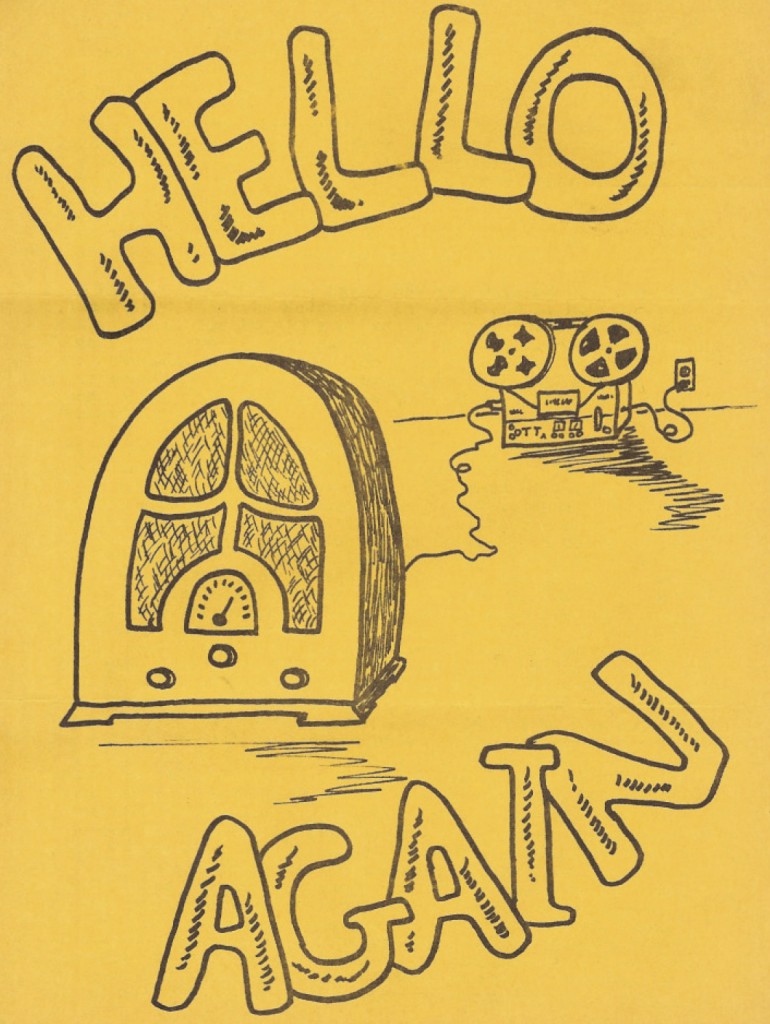The Formation of a Bootleg Radio Fan Culture
Post by Eleanor Patterson, University of Wisconsin-Madison
In 1971, radio fan Sal Trapani published an open plea in the old-time radio fanzines Epilogue and Hello Again to organize and support a convention for “golden radio buffs.[1]” Epilogue’s editor George Jennings added a note under Trapani’s piece, writing, “we are reaching a stage of development in the collecting of old radio where there should be enough interested parties to support the convention theme.” Indeed, by the early 1970s, fandom surrounding classic network era radio had exploded. Local “Old Time Radio” (OTR) fan clubs existed in many major cities, including Chicago, New York, Los Angeles, Denver, Buffalo, San Francisco, and others. Several prominent fanzines and newsletters produced for OTR collectors were being published and distributed. Many fans were producing fan shows that rebroadcast classic recordings of radio from their collections on local public, college, and commercial radio stations.
In October, 1971, the first radio fan convention was held in New Haven, Connecticut. Initially titled the Society of American Vintage-Radio Enthusiasts Convention, it would later be called the Friends of Old Time Radio Convention in 1976. While scholars like Elena Razlogova and Matt Hills have written about radio fandom, this area of scholarship has been largely ignored in critical media audience studies. I find this oversight even more surprising in the case of OTR fans, because their community has existed at least since August 26th, 1956, when the Radio Historic Society of America (RHSA) joined together to trade tapes. The fan community continues to have a strong presence both online and in larger cities. This post is part of a larger research project, in which I intervene in radio history to consider the formation of a radio fan community that circulated residual radio from the classic network era.
Collecting radio as a hobby really began to take off in the United States in the late 1940s, when the post-war consumer electronics market expanded with hi-fidelity sound technology and a community of amateur audiophiles emerged. American hobbyists began the widespread collection of radio recordings after the introduction of magnetic tape reel-to-reel home recording equipment in the late 1940s by companies like Ampex and 3M. This small but engaged subset of the hi-fi culture used them to record programs off-air, reformat from transcription discs to tape, and/or duplicate programs from other hobbyists’ recordings. Radio collecting was very much a bootleg culture, because most radio producers never commercially released radio recordings. This is especially true for the genres radio collectors valued most, the popular drama, comedy, variety, horror, and science fiction programs that enjoyed long serialized runs via network or syndicated distribution- shows like Yours Truly, Johnny Dollar (which remains one of the most downloaded classic radio show on The Internet Archive). The lack of any official catalog or episode guide for collectors, in addition to the nature of obtaining radio recordings over the air or on the black market, made this collecting a collaborative bootleg culture.

Certificate sent to fans who joined the first official OTR club, the Radio Historical Society of America, which existed from 1956 – 77.
OTR fans have not, for the most part been productive in the tradition sense within fan studies. They did not poach elements from their favorite radio shows to produce their own fan fiction, fan vids, fan art, songs or other original fan media texts.[2] Certainly, OTR fans were very productive in the extensive amount of fanzines that were published, often at home using a mimeograph machine. Over OTR 10 fanzines emerged between 1966-1980. However, as Richard Belk notes, even the act of collecting is an act of production, because as they actively and selectively acquire objects for their collection, “Collectors create, combine classify, and curate the objects they acquire in such a way that a new product, that collection, emerges. In the process, they also produce meanings.[3]” I see OTR fan labor in building radio collections production in four specific ways.
First, their work is productive in acquiring radio recordings from disparate sources and bringing them together in their collections as archives of complete series. Fans tracked down recordings from radio producers who had been active in the classic radio era; they knocked on doors of local radio stations, taped broadcasts off the air, and even some were rumored to have stolen recordings from the networks archives in New York. The work collectors did amassing and circulating recordings introduced popular culture to radio as a physical object that could be collecting, exulted, and replayed on-demand at home. Second, OTR collectors created in-depth episode guides, known as “logs” within the OTR culture. This process included spending hours doing research in a local libraries’ microfilm, reading newspapers and radio magazines from the network era, and listening for clues in the broadcasts themselves. Third, OTR fans duplicated sound recordings. Fans experimented with DIY hi-fidelity sound recording practices, making equalizers, adjusting tape speeds, and experimenting with tape brands to reformat and improve sound quality. The labor invested in augmenting radio recordings’ sound quality through duplication and technological modification created essentially new sound recording artifacts. Lastly, OTR fans were productive in the meanings that emerging surrounding classic radio in a post-civil rights, post-women’s liberation movement era. Fanzines like Collector’s Corner and Hello Again published editorials and articles that debated whether programs like The Lone Ranger or Amos ‘n’ Andy are racist. Think-pieces on historical significance of female radio personalities like Agnes Moorehead or all-female radio stations like WHER of Memphis illuminated the often invisible history of women in radio. As OTR collectors debated and discussed the cultural significance of classic radio, they produced new affective relationships with these radio programs, while also establishing interpersonal relationships with each other.
The work of collectors unearthing, historicizing, and improving the sound of radio recordings resulted in the development of an unofficial archive of radio programs. Hilmes [4] has noted the critical neglect to radio’s artistic legacy by the broadcast networks, U.S. governmental archives and institutions of memory and culture, and by academics created an environment in which current practitioners and audiences are not aware of U.S. radio history. Considering this, and the absolute dearth of any official centralized radio archive during the 1950s, 60s, and 70s in the United States, radio fans’ collaborative work created an unofficial archive that made broadcast recordings available to the general public. Today, radio fans upload their collections to websites like The Internet Archive, and have donated their collections to the Library of Congress, where students, scholars and others have access to radio programs produced in the classic network era. Considering the complete disinterest of the original producers and networks in preserving these recordings, scholars and newer OTR fans are certainly indebted to work radio collectors did in the mid and late twentieth century preserving (and often improving the sound quality of) our radio heritage.
[1] Sal Trapani, “Convention?” Epilogue, Spring 1971, 13.
[2] Henry Jenkins, Textual Poachers: Television Fans and Participatory Culture, (New York: Routledge, 1992).
[3] Richard Belk, Collecting in a consumer society, (London: Routledge,1995), 55.
[4] Michele Hilmes, “The lost critical history of radio,” Australian Journalism Review, 36(2), 11 -22.




Sal Trapani was a close and dear friend. I mourn his passing and miss him all the more as time passes. He and Ira Shpritzen – I always have trouble spelling his name – did a great deal to preserve interest in OTR.
At the time, the electrons were still “visible”, radio tubes or valves glowed in the dark and anyone with some technical knowledge knew what a triode or pentode was and what it was for. You could get another set and take out a valve and replace a broken one with it. You could manipulate the UHF FM receiver to better capture police frequencies and even turn a receiver into a transmitter (which in most states though was a criminal offense unless you had a ham license). These times have passed, I still started soldering “three-legged” transistors of Shockley origin, then micro integrated circuits came and it is now all mostly software, if you want to “hack” something.